To elevate your mobile landscape photography, invest in a tripod that suits your needs. Consider lightweight carbon fiber for portability or sturdy aluminum for stability. Compact tripods are great for on-the-go shooting, while full-size options offer maximum steadiness. Look for features like adjustable leg angles and weight hooks for windy conditions. Quick-release systems and smartphone-specific mounts guarantee easy setup and secure phone placement. Don't forget flexible tripods for unique angles and remote shutter options to reduce camera shake. The right tripod can transform your mobile shots from amateur to professional-grade. Dive deeper to discover how each feature can enhance your landscape photography game.
Choosing the Right Tripod Material
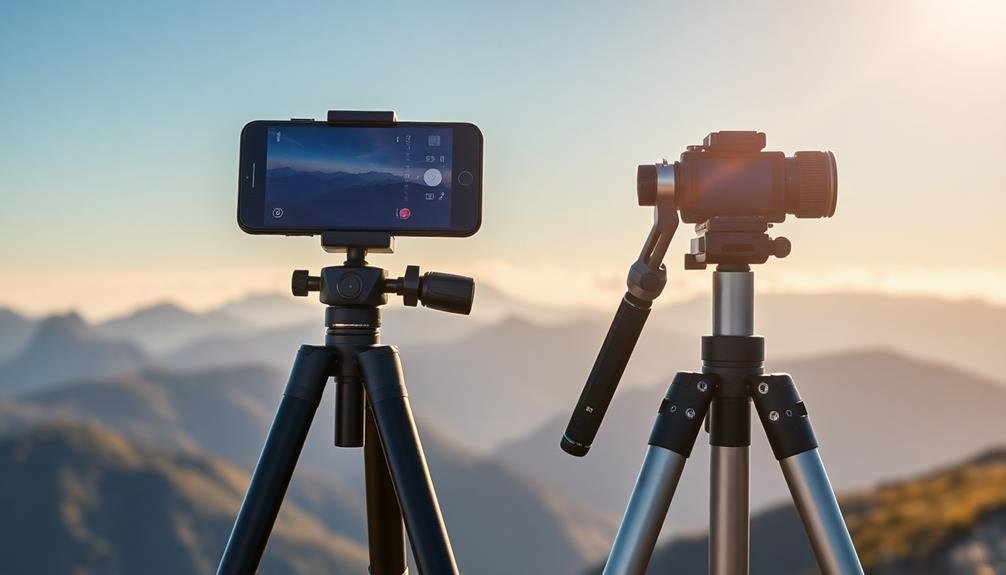
When it comes to tripod materials, you'll typically encounter three main options: aluminum, carbon fiber, and basalt. Each has its own set of advantages and drawbacks, so it's crucial to evaluate your specific needs and shooting conditions.
Aluminum tripods are the most affordable and durable option. They're great for beginners and can withstand rough handling. However, they're heavier than other materials, which might be a concern if you're hiking long distances.
Carbon fiber tripods are lightweight and offer excellent vibration dampening properties. They're ideal for mobile photographers who prioritize portability and image quality. The downside? They're more expensive and can be brittle in extreme cold.
Basalt tripods strike a balance between aluminum and carbon fiber. They're lighter than aluminum but more affordable than carbon fiber. They offer good vibration dampening and thermal stability, making them suitable for various weather conditions.
Evaluate factors like weight, stability, and budget when choosing your tripod material. If you're frequently on the move, a lightweight carbon fiber or basalt tripod might be worth the investment.
For studio or short outdoor shoots, an aluminum tripod could suffice.
Compact vs. Full-Size Tripods
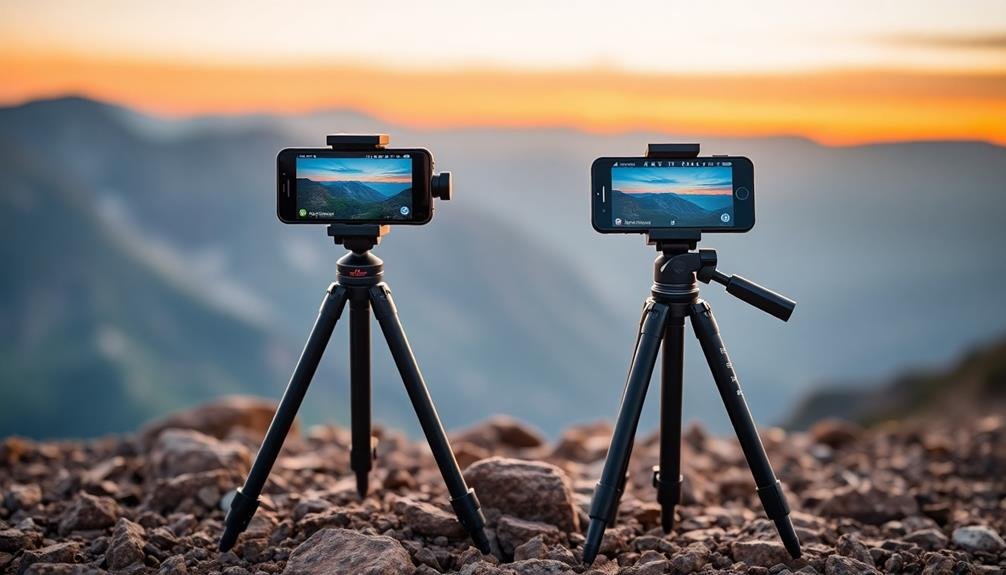
When choosing between compact and full-size tripods for mobile landscape photography, you'll need to weigh portability against stability.
Compact tripods are lighter and easier to carry on long hikes, but they often sacrifice stability, especially in windy conditions.
Full-size tripods offer superior stability and versatility, but they're bulkier and take longer to set up, which could mean missing fleeting moments of perfect light.
Portability and Stability Comparison
One of the most essential decisions you'll face when choosing a tripod for mobile landscape photography is whether to opt for a compact or full-size model. This choice ultimately boils down to a trade-off between portability and stability.
Compact tripods excel in portability. They're lightweight, often weighing less than 2 pounds, and can easily fit into a backpack or even a large pocket. You'll appreciate their convenience when hiking long distances or traveling by air.
However, their smaller size comes at the cost of stability, especially in windy conditions or with heavier smartphone setups.
Full-size tripods, on the other hand, offer superior stability. Their longer legs and heavier build provide a solid foundation for your mobile device, ensuring sharp images even in challenging environments.
They're particularly useful for long exposures or when using additional lenses. The downside is their bulk and weight, which can be cumbersome during extended hikes or travels.
Your choice will depend on your specific needs. If you prioritize ease of transport and quick setup, a compact tripod may be ideal.
But if image quality and versatility are paramount, a full-size tripod might be worth the extra effort.
Setup Time Differences
Setup time can make or break your mobile landscape photography experience, especially when you're chasing fleeting moments of light.
Compact tripods generally offer faster setup times compared to their full-size counterparts. With fewer leg sections and simpler locking mechanisms, you can often deploy a compact tripod in under 30 seconds.
Full-size tripods, while more stable, typically require more time to set up. Their multiple leg sections and more complex locking systems can take anywhere from 45 seconds to two minutes to fully extend and secure.
However, this extra time often translates to greater stability and height adjustability.
Consider your shooting style and typical locations when choosing between compact and full-size tripods. If you frequently shoot in fast-changing conditions or need to move quickly between spots, a compact tripod's swift setup might be ideal.
For more deliberate compositions or when maximum stability is essential, the longer setup time of a full-size tripod may be worth the trade-off.
Some manufacturers now offer hybrid designs that combine quick setup features with the stability of larger tripods, potentially offering the best of both worlds for mobile landscape photographers.
Stability Features for Windy Conditions
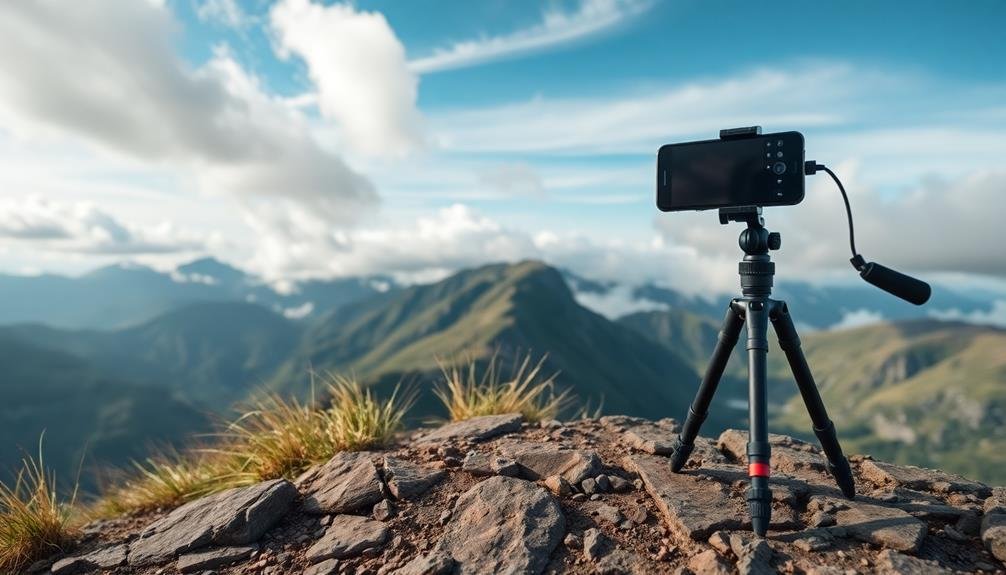
Gusts and breezes can wreak havoc on your mobile landscape photography, making stability essential in windy conditions. To combat wind-induced camera shake, look for tripods with specific features designed to enhance stability.
Opt for tripods with adjustable leg angles, allowing you to spread the legs wider for a lower center of gravity and increased stability. Rubber feet with retractable spikes provide better traction on various surfaces, reducing the risk of slippage in windy weather.
Consider tripods with a hook at the bottom of the center column. This allows you to hang a weight, like your camera bag, for added stability. Some models feature removable center columns, enabling you to position your phone closer to the ground for improved stability.
Look for tripods with wind-resistant materials and designs. Carbon fiber legs offer rigidity while remaining lightweight. Avoid extending the center column fully, as this can introduce instability.
Choose a sturdy ball head or pan-tilt head that can securely lock your phone in place. Some heads feature tension control, allowing you to adjust the resistance for smoother movements in windy conditions.
Quick-Release Systems for Smartphones
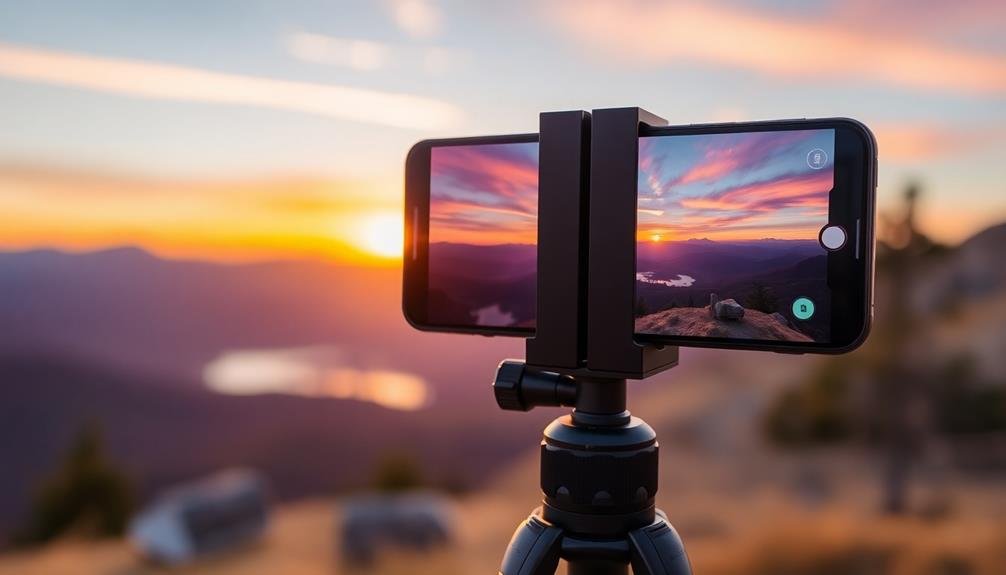
In light of the dynamic nature of mobile photography, quick-release systems for smartphones have become essential accessories for landscape enthusiasts. These systems allow you to swiftly attach and detach your phone from the tripod, ensuring you don't miss fleeting moments in nature.
Look for a system that's compatible with your specific phone model and case. Many quick-release systems use a universal clamp design that adjusts to fit various phone sizes. You'll want one that's sturdy enough to hold your device securely while allowing easy manipulation for composition.
Some systems feature a ball head for smooth adjustments, while others offer pan-and-tilt functionality. Consider systems with additional mounting options, like cold shoe mounts for attaching lights or microphones. This versatility can expand your creative possibilities in the field.
You'll also find quick-release plates that attach directly to your phone case, offering a seamless integration with your tripod. When choosing a quick-release system, prioritize ease of use and reliability. You don't want to fumble with complicated mechanisms when capturing a stunning sunset.
Opt for systems made from durable materials like aluminum or high-grade plastics to withstand outdoor conditions.
Flexible Tripods for Unique Angles
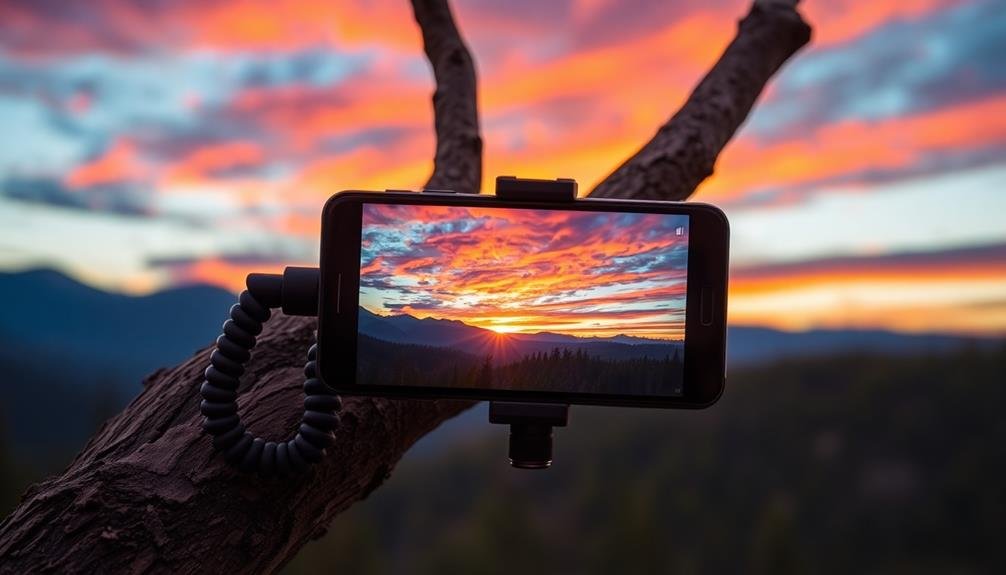
Numerous landscape photographers are turning to flexible tripods for their mobile setups, thanks to their versatility in capturing unique angles. These bendable supports allow you to wrap them around tree branches, railings, or even rocks, giving you the freedom to position your smartphone in ways traditional tripods can't.
When choosing a flexible tripod, consider its weight capacity, grip quality, and overall durability. Here's a comparison of popular options:
| Feature | GorillaPod Mobile | Joby GripTight ONE | Manfrotto PIXI |
|---|---|---|---|
| Max Load | 1kg | 1kg | 1kg |
| Leg Material | Rubber | ABS Plastic | Aluminum |
| Phone Adapter | Included | Included | Sold Separately |
You'll find that flexible tripods excel in situations where space is limited or when you need to get close to the ground for low-angle shots. They're also great for vlogging or selfies, as you can easily bend the legs to create a stable grip. Remember to check the tripod's compatibility with your smartphone model and case before purchasing. With a flexible tripod in your kit, you'll be able to capture stunning landscape photos from perspectives you never thought possible.
Tripod Height and Terrain Adaptability
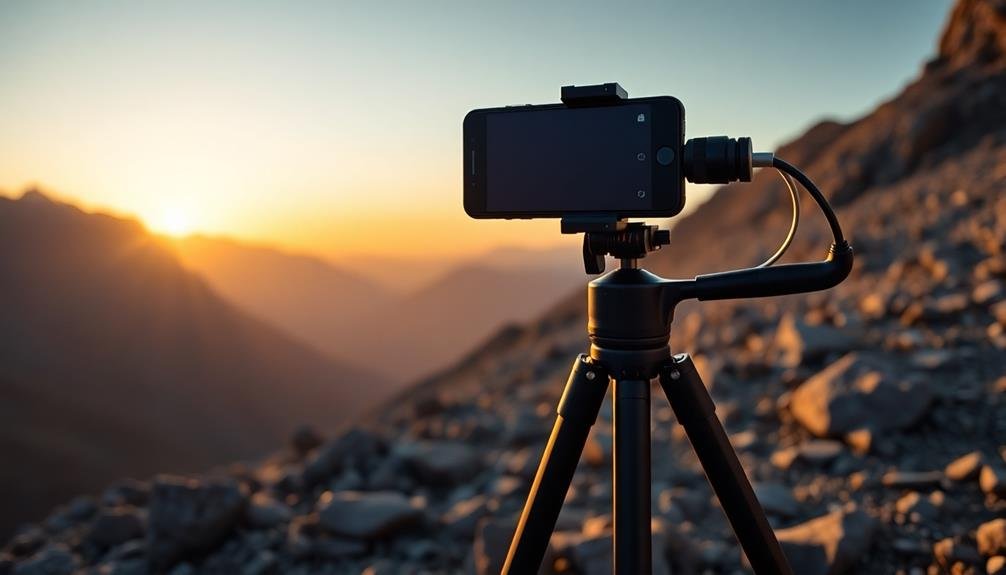
When it comes to mobile landscape photography, the height and terrain adaptability of your tripod can make or break your shot.
You'll want a tripod that extends to eye level for comfortable shooting but also collapses small enough for easy transport. Look for models with adjustable leg lengths and angles to accommodate uneven terrain.
Multi-section legs offer greater height versatility, allowing you to set up on slopes or in water. Some tripods feature spiked feet for stability on soft ground, while rubber feet work best on hard surfaces.
Consider a tripod with a center column that can be inverted for low-angle shots or removed entirely for ground-level perspectives.
For maximum adaptability, choose a tripod with independently adjustable legs. This feature lets you position your camera precisely, even on challenging surfaces like rocky outcrops or steep hillsides.
Don't forget about weight capacity – verify your tripod can support your smartphone and any additional gear like lenses or filters.
Ultimately, the ideal tripod balances height range, stability, and portability.
Smartphone-Specific Tripod Mounts
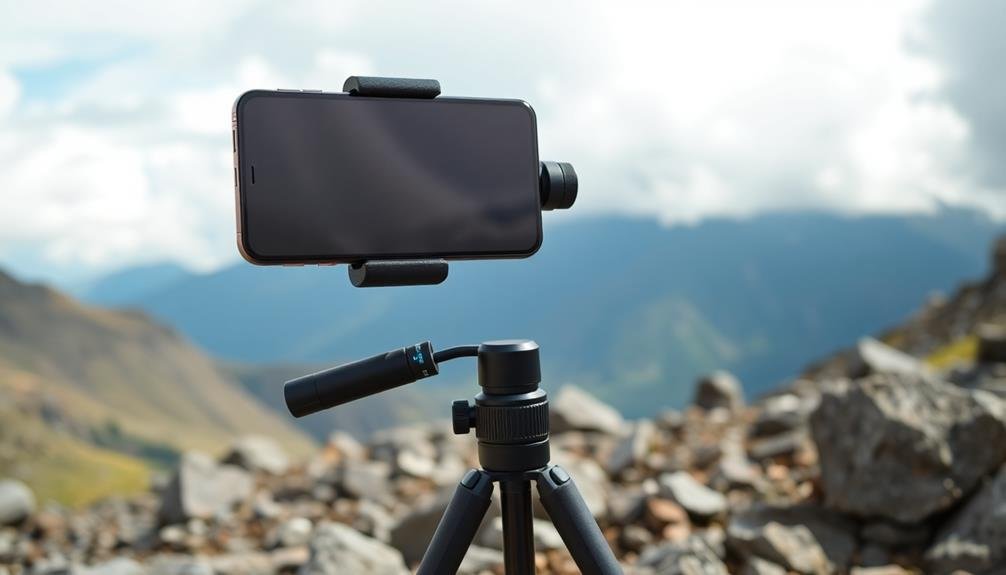
When choosing a tripod mount for your smartphone, you'll need to decide between universal mounts that fit various devices or phone-specific options designed for your exact model.
Consider the mount's grip strength and security to guarantee your device stays firmly in place during long exposures or windy conditions.
Look for mounts with quick-release functionality, allowing you to swiftly attach and detach your phone for spontaneous shots or rapid adjustments.
Universal vs. Phone-Specific Mounts
As you explore tripod options for mobile landscape photography, you'll encounter two main types of smartphone mounts: universal and phone-specific.
Universal mounts are designed to accommodate a wide range of phone sizes and models, offering flexibility if you frequently upgrade your device or use multiple phones. These mounts typically feature adjustable clamps or spring-loaded mechanisms to securely hold your phone in place.
On the other hand, phone-specific mounts are tailored to fit particular smartphone models or brands. They often provide a more precise fit and may offer additional features like access to specific ports or buttons. While these mounts can be more secure and streamlined, they're less versatile if you change phones.
When choosing between universal and phone-specific mounts, consider your long-term needs. If you're committed to a particular phone model or brand, a specific mount might offer the best fit and functionality.
However, if you value versatility or plan to upgrade your phone soon, a universal mount could be the better investment. Some photographers opt for both types, using a universal mount for everyday shooting and a phone-specific mount for more demanding conditions or specialized setups.
Grip Strength and Security
Smartphone-specific tripod mounts stand out for their exceptional grip strength and security. When you're capturing breathtaking landscapes, you need to trust that your device won't budge or slip. These mounts are designed with precision to fit your phone model perfectly, ensuring a snug and secure hold.
You'll find that most phone-specific mounts use a combination of rubberized grips and adjustable clamps. This dual approach maximizes friction and prevents any unwanted movement during long exposures or time-lapses.
Some advanced models even incorporate locking mechanisms for added peace of mind.
The secure grip allows you to position your phone at various angles without fear of it falling out. You can confidently shoot low-angle compositions or even suspend your device for unique perspectives.
Many mounts also feature quick-release systems, letting you swiftly detach your phone when needed.
Quick-Release Functionality
Photography enthusiasts appreciate the convenience of quick-release functionality in smartphone-specific tripod mounts. These mounts allow you to swiftly attach and detach your smartphone from the tripod, saving precious time when capturing fleeting moments in landscape photography.
You'll find that quick-release systems come in various designs, but they all serve the same purpose: to streamline your shooting process.
When choosing a quick-release mount for your mobile landscape photography, consider these key features:
- Compatibility with your smartphone model
- Secure locking mechanism to prevent accidental releases
- Adjustable grip width to accommodate different phone sizes
- 360-degree rotation capabilities for versatile framing
- Lightweight construction for easy portability
Quick-release functionality isn't just about speed; it's about flexibility. You can quickly switch between handheld and tripod-mounted shots, allowing you to adapt to changing lighting conditions or compositions.
This versatility is especially valuable when you're working in challenging outdoor environments. By investing in a quality quick-release mount, you'll enhance your mobile landscape photography workflow, giving you more time to focus on capturing stunning images rather than fiddling with equipment.
Remote Shutter Options
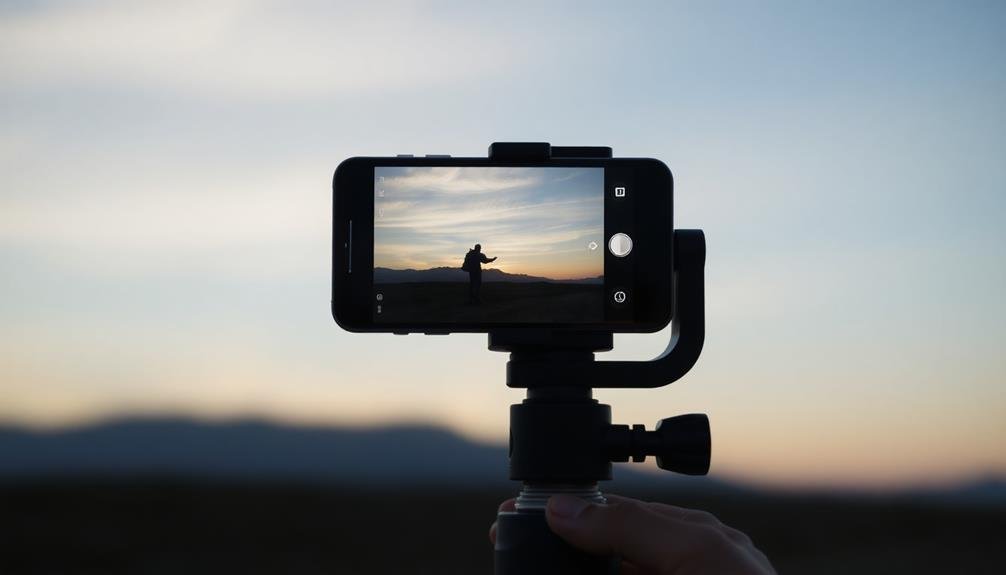
Remote shutter options can greatly enhance your mobile landscape photography experience. These accessories allow you to trigger your smartphone's camera without physically touching the device, reducing camera shake and enabling you to capture sharper images, especially in low-light conditions or when using slow shutter speeds.
Bluetooth remotes are popular choices, offering wireless connectivity and compatibility with most smartphones. They're compact, easy to use, and often have a range of up to 30 feet. Some models even include additional features like zoom control or video start/stop functions.
Wired remote shutters provide a reliable alternative, connecting directly to your phone's headphone jack or charging port. They're less likely to experience interference and don't require battery changes, but they limit your movement due to cable length.
Many tripods come with built-in remote shutter functionality, either through a detachable Bluetooth remote or a wired connection integrated into the tripod's design. This convenient feature guarantees you always have a remote shutter option available when setting up your mobile landscape shots.
When choosing a remote shutter, consider your specific needs, such as range, battery life, and compatibility with your smartphone model and photography apps.
Tripod Weight and Portability
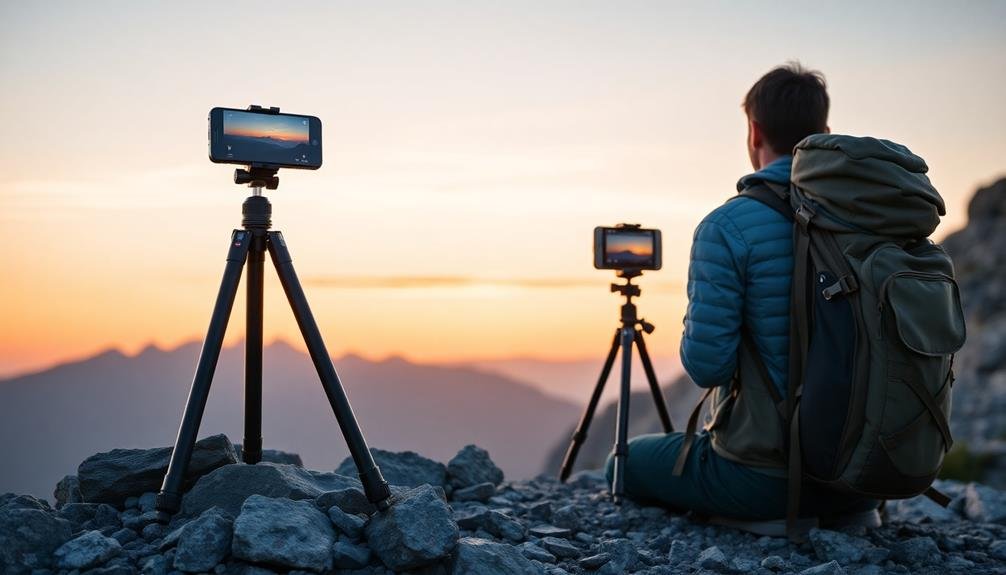
When considering tripods for mobile landscape photography, weight and portability are essential factors. You'll want a tripod that's light enough to carry on long hikes but sturdy enough to support your smartphone in various conditions.
Look for tripods made from lightweight materials like carbon fiber or aluminum. Collapsible designs that fold down to compact sizes are ideal for fitting into your backpack or camera bag.
Consider the trade-offs between weight and stability. While ultralight tripods are easy to carry, they may sacrifice some stability in windy conditions. Conversely, heavier tripods offer more stability but can be cumbersome on long treks.
Find a balance that suits your specific needs and shooting style.
Here's what to look for in a portable tripod for mobile landscape photography:
- Lightweight construction (under 3 pounds)
- Compact folded size (less than 15 inches)
- Quick-release legs for easy setup
- Adjustable height (at least 50 inches extended)
- Built-in smartphone mount or compatible adapter
Frequently Asked Questions
Can I Use a DSLR Tripod for My Smartphone?
Yes, you can use a DSLR tripod for your smartphone. You'll need a smartphone adapter to attach your device securely. It's a great way to stabilize your shots and improve your mobile photography, especially in low-light conditions.
How Do I Clean and Maintain My Tripod?
To clean and maintain your tripod, you'll want to regularly wipe it down with a damp cloth. Remove any dirt or sand from joints and legs. Lubricate moving parts with silicone spray. Avoid submerging it in water.
Are Tripods Allowed in All National Parks and Tourist Locations?
While most national parks allow tripods, you'll find restrictions in some locations. It's best to check specific park rules beforehand. Tourist sites vary; some permit tripods, others don't. Always research and respect local guidelines when planning your photography outings.
What's the Average Lifespan of a Good Quality Tripod?
You can expect a high-quality tripod to last 5-10 years with proper care. However, your usage frequency, maintenance habits, and environmental conditions will impact its lifespan. Regular cleaning and careful handling can extend your tripod's durability considerably.
Can I Use My Tripod for Both Photography and Videography?
You'll find that most tripods are versatile enough for both photography and videography. They'll stabilize your camera, allowing for sharp images and smooth video footage. Just guarantee it's sturdy enough to support your equipment's weight.
In Summary
You've now got the tools to elevate your mobile landscape photography. Remember, there's no one-size-fits-all solution. Consider your specific needs and shooting style when choosing a tripod. Whether it's a lightweight carbon fiber model for hiking or a flexible option for creative angles, the right tripod will stabilize your shots and expand your creative possibilities. Don't forget to experiment with different heights and remote shutter options. Now go out and capture those stunning landscapes!

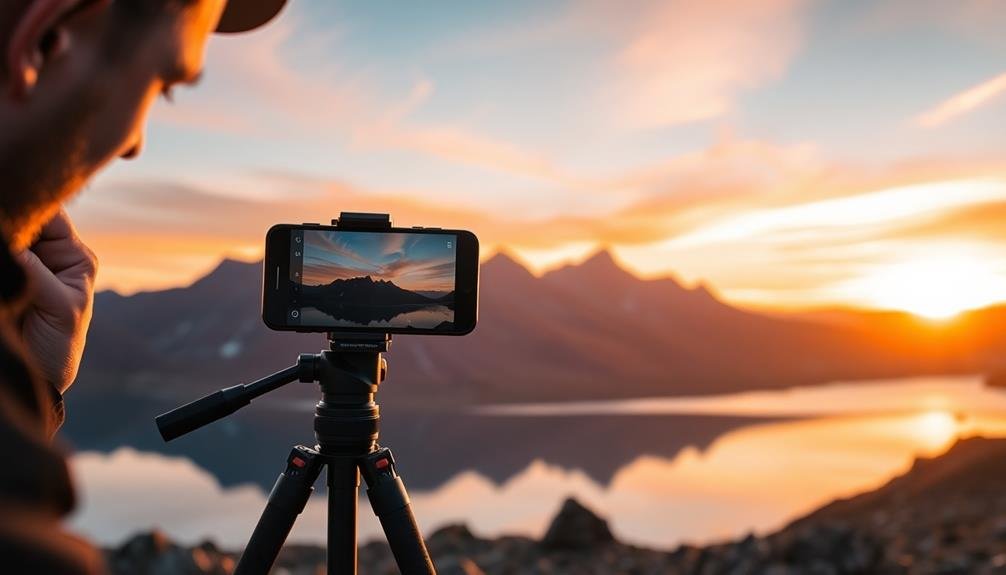



Leave a Reply